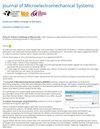基于35%钪掺杂氮化铝的51.3 GHz超模体声谐振器
IF 3.1
3区 工程技术
Q2 ENGINEERING, ELECTRICAL & ELECTRONIC
引用次数: 0
摘要
本研究展示了一种采用35%钪掺杂氮化铝(Sc0.35Al0.65N)作为压电层的过模体声学谐振器(OBAR)设计。这里介绍的ScAlN OBAR是一个体声波(BAW)谐振器,它在由ScAlN层和一组交替金属层形成的堆栈中激发第二个泛音。金属电极同时充当声腔和声布拉格镜。单个谐振器通过厚的浮动电极和顶部互连相互连接,形成本文所示的器件。所制备的ScAlN OBAR性能最佳,其串联谐振频率为51.3 GHz,机电耦合($k_{t}^{2}$)为6.1%,串联谐振品质因子(Q)为108。对不同几何形状的ScAlN OBAR器件的测量表明,Q随着单个谐振器周长和面积的增加而增加,$k_{t}^{2}$随着串联谐振器数量的增加而增加。材料损失和表面粗糙度与相关的声能泄漏讨论了阻尼在这些毫米波谐振器可能的来源。研究为进一步的技术改进开辟了道路,并表明ScAlN OBAR是毫米波声学和滤波应用的有前途的设备。(2025 - 0071)本文章由计算机程序翻译,如有差异,请以英文原文为准。
51.3 GHz Overmoded Bulk Acoustic Resonator Using 35% Scandium Doped Aluminum Nitride
This work demonstrates an Overmoded Bulk Acoustic Resonator (OBAR) design that incorporates 35% Scandium doped Aluminum Nitride (Sc0.35Al0.65N) as the piezoelectric layer. The ScAlN OBAR presented here is a Bulk Acoustic Wave (BAW) resonator that excites a second overtone within a stack formed by a ScAlN layer and a set of alternating metallic layers. The metal electrodes act simultaneously as the acoustic cavity and as acoustic Bragg mirrors. Individual resonators are connected to each other by thick floating electrodes and top interconnects to form the devices demonstrated herein. The fabricated ScAlN OBAR with best performance exhibits a series resonant frequency of 51.3 GHz, electromechanical coupling ( $k_{t}^{2}$ ) of 6.1% and a Quality factor (Q) at series resonance of 108. The measurements of various ScAlN OBAR devices with different geometries show that Q is increasing as the perimeter and area of the individual resonator increases and $k_{t}^{2}$ is increasing as the number of resonators in series increases. Material losses and surface roughness with associated acoustic energy leakage are discussed as possible sources of damping in these mmWave resonators. The investigations trace a path for further technological improvement and show that the ScAlN OBAR is a promising device for mmWave acoustics and filtering applications. [2025-0071]
求助全文
通过发布文献求助,成功后即可免费获取论文全文。
去求助
来源期刊

Journal of Microelectromechanical Systems
工程技术-工程:电子与电气
CiteScore
6.20
自引率
7.40%
发文量
115
审稿时长
7.5 months
期刊介绍:
The topics of interest include, but are not limited to: devices ranging in size from microns to millimeters, IC-compatible fabrication techniques, other fabrication techniques, measurement of micro phenomena, theoretical results, new materials and designs, micro actuators, micro robots, micro batteries, bearings, wear, reliability, electrical interconnections, micro telemanipulation, and standards appropriate to MEMS. Application examples and application oriented devices in fluidics, optics, bio-medical engineering, etc., are also of central interest.
 求助内容:
求助内容: 应助结果提醒方式:
应助结果提醒方式:


